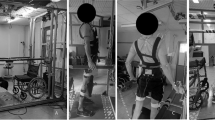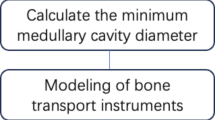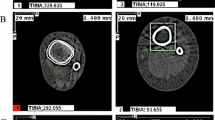Abstract
Study design:
A cross-sectional study.
Objectives:
To measure the change of structural and material properties at different sites of the tibia in spinal cord-injured patients using peripheral quantitative computerised tomography (pQCT).
Setting:
Orthopaedic research centre (UK).
Methods:
Thirty-one subjects were measured—eight with acute spinal cord injury (SCI), nine with chronic SCI and fourteen able-bodied controls. pQCT scans were performed at 2% (proximal), 34% (diaphyseal) and 96% (distal) along the tibia from the tibial plateau. Structural measures of bone were calculated, and volumetric bone mineral density (vBMD) was also measured at all three levels. Muscle cross-sectional area was measured at the diaphyseal level.
Results:
Structurally, there were changes in the cortical bone; in the diaphysis, the shape of the cross-section changed to offer less resistance to AP bending, and the cross-sectional area of the cortical shell decreased both proximally and distally. There were corresponding changes in vBMD in the anterior aspect of the cortical diaphysis, as well as proximal and distal trabecular bone. Changes in muscle occurred more rapidly than changes in bone.
Conclusion:
There were clear changes of both structure and material at all three levels of the tibia in chronic SCI patients. These changes were consistent with specific adaptations to reduced local mechanical loading conditions. To assess fracture risk in SCI and also to monitor the effect of therapeutic interventions, the structure of the bone should be considered in addition to trabecular bone mineral density.
Similar content being viewed by others
Log in or create a free account to read this content
Gain free access to this article, as well as selected content from this journal and more on nature.com
or
References
Jiang S-D, Dai L-Y, Jiang L-S . Osteoporosis after spinal cord injury. Osteoporos Int 2006; 17: 180–192.
Zehnder Y, Luthi M, Michel D, Knecht H, Perrelet R, Neto I et al. Long-term changes in bone metabolism, bone mineral density, quatitative ultrasound parameters, and fracture incidence after spinal cord injury: a cross-sectional study in 100 paraplegic men. Osteoporos Int 2004; 15: 180–189.
Biering-Sorensen F, Hansen B, Lee BSB . Non-pharmocological treatment and prevention of bone loss after spinal cord injury: a systematic review. Spinal Cord 2009; 47: 508–518.
Bubbear JS, Gall A, Middleton FRI, Ferguson-Pell M, Swaminathan R, Keen R . Early treatment with zolendronic acid prevents bone loss at the hip following acute spinal cord injury. Osteoporos Int 2011; 22: 271–279.
Bauman WA, Schwartz E, Song ISY, Kirshblum S, Cirnigliaro C, Morrison N et al. Dual-energy X-ray absorptiometry overestimates bone mineral density of the lumbar spine in persons with spinal cord injury. Spinal Cord 2009; 47: 628–633.
Eser P, Frotzler A, Zehnder Y, Wick L, Knecht H, Denoth J et al. Relationship between the duration of paralysis and bone structure; a pQCT study of spinal cord injured individuals. Bone 2004; 34: 869–880.
Frotzler A, Berger M, Knecht H, Eser P . Bone steady-state is established at reduced bone strength after spinal cord injury: a longitudinal study using peripheral quantitative computed tomography. Bone 2008; 43: 549–555.
Coupaud S, McLean AN, Allan DB . Role of peripheral quantitative computed tomography in identifying disuse osteoporosis in paraplegia. Skeletal Radiol 2009; 38: 989–995.
Rittweger J, Gerrits K, Altenburg T, Reeves N, Maganaris CN, de Haan A . Bone adaptation to altered loading after spinal cord injury: a study of bone and muscle strength. J Musculoskelet Neuronal Interact 2006; 6: 269–276.
Cappozza RF, Feldman S, Mortarina P, Reina PS, Schiessl H, Rittweger J et al. Structural analysis of the human tibia by tomographic (pQCT) serial scans. J Anat 2010; 216: 470–481.
Lanyon LE, Hampson WG, Goodship AE, Shah JS . Bone deformation recorded in vivo from strain gauges attached to the human tibial shaft. Acta Orthop Scand 1975; 46: 256–268.
Tami AE, Schaffler MB, Knothe-Tate ML . Probing the tissue to subcellular level structure underlying bone's molecular sieving function. Biorheology 2003; 40: 577–590.
Holzer G, von Skrbensky G, Holzer L, Pichl W . Hip fractures and the contribution of cortical versus trabecular bone to femoral neck strength. J Bone Miner Res 2009; 24: 468–474.
Acknowledgements
We are grateful to the Action Medical Research for funding this work.
Author information
Authors and Affiliations
Corresponding author
Ethics declarations
Competing interests
The authors declare no conflict of interest.
Rights and permissions
About this article
Cite this article
McCarthy, I., Bloomer, Z., Gall, A. et al. Changes in the structural and material properties of the tibia in patients with spinal cord injury. Spinal Cord 50, 333–337 (2012). https://doi.org/10.1038/sc.2011.143
Received:
Revised:
Accepted:
Published:
Issue date:
DOI: https://doi.org/10.1038/sc.2011.143
Keywords
This article is cited by
-
Alteration of Volumetric Bone Mineral Density Parameters in Men with Spinal Cord Injury
Calcified Tissue International (2023)
-
Osteoporosis in the lower extremities in chronic spinal cord injury
Spinal Cord (2020)
-
Bone loss at the distal femur and proximal tibia in persons with spinal cord injury: imaging approaches, risk of fracture, and potential treatment options
Osteoporosis International (2017)
-
Pixel-Based DXA-Derived Structural Properties Strongly Correlate with pQCT Measures at the One-Third Distal Femur Site
Annals of Biomedical Engineering (2017)
-
FES-rowing attenuates bone loss following spinal cord injury as assessed by HR-pQCT
Spinal Cord Series and Cases (2016)



